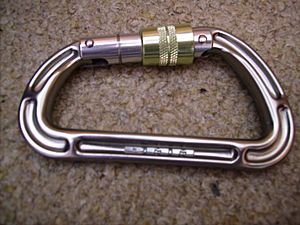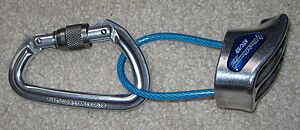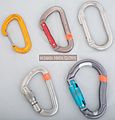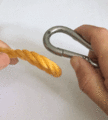Carabiner facts for kids
A carabiner is a strong metal loop with a special opening side called a gate. The other side is called the spine. Carabiners are super useful tools! People use them for many things, like rock climbing, sailing, and even canoeing. They are also important for building tall buildings or cleaning windows safely.
The word "carabiner" comes from the German word "Karabinerhaken". This means "hook for a carbine", which was a type of rifle. Climbing carabiners are very strong. Many can hold more than 20 kN of force. That's like holding up two elephants! When a climber is being held safely by a rope (this is called belaying), a special carabiner with a locking feature must be used. This stops it from opening by accident and keeps the climber safe.
Different Types of Carabiners
Carabiners come in different shapes, and each shape is good for different things:
- HMS (Pear-shaped): This type is often used in rock climbing. HMS stands for a German word that means "half-mast hitch safety". It's shaped like a pear, which helps a special knot called the Munter Hitch work smoothly. This knot is used for belaying a climber. HMS carabiners almost always have a locking device for safety.
- D-shape: This carabiner looks like the letter "D". Most of the weight goes to the strong, straight side (the spine). This makes D-shaped carabiners very strong. They can be a bit more expensive because of their strength. Bigger D-shaped carabiners are sometimes called Offset-D.
- Oval: This type is shaped like an oval. They are usually the most affordable carabiners. People often use them for organizing climbing gear or for a type of climbing called aid climbing. Oval carabiners are generally not as strong as the D-shape or HMS types.
Both D-shape and Oval carabiners can be found with or without locking devices. Carabiners without a locking device are often used in quickdraws. Quickdraws are used to connect a climbing rope to safety points on a rock wall.
Images for kids
See also
 In Spanish: Mosquetón para niños
In Spanish: Mosquetón para niños






